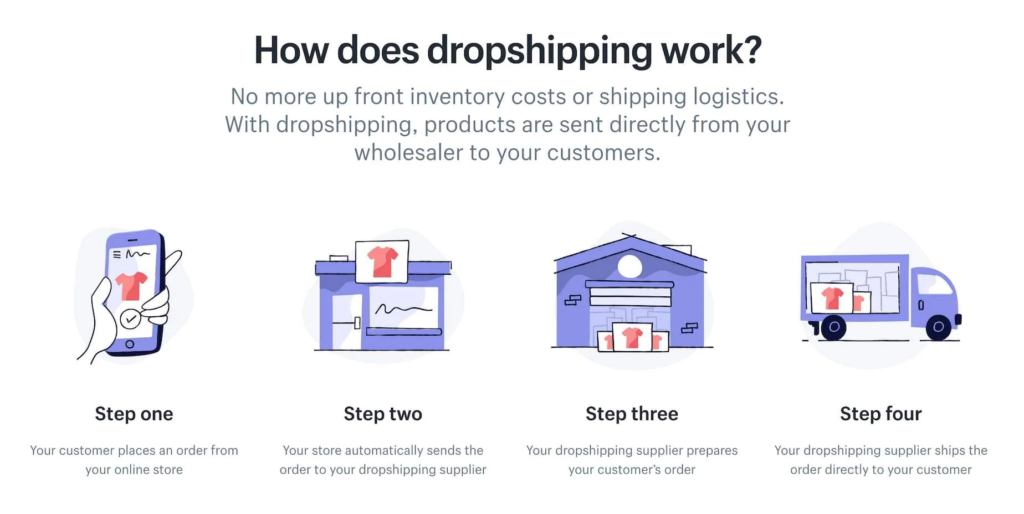How to Set Up Your Dropshipping Store in One Weekend

Dropshipping is an e-commerce retail model that allows stores to sell products without keeping any physical inventory. In dropshipping, the store sells the product to the consumer, then passes at the income order to a third-party supplier, who then ships the order without delay to the purchaser on behalf of the store. It is like someone grab the order by their marketing skills and the supplier complete the order and the marketer get his commission. Dropshipping dealers do now no longer want to spend money on any product inventory, warehouse or garage space, and do now no longer deal with the success process.
Due to the low overhead access charges and ease of beginning a dropshipping business, it has turn out to be a famous and handy Business version for e-trade retailers, who can run worthwhile shops with smooth setup and little or no risk. Dropshipping has been a contributor to the ubiquity of e-trade, because it allowed many gamers to saturate markets with area of interest offerings.
Retailers that use dropshipping forfeit some control over the customer experience; therefore, having exceptional customer support is critical for buyer retention.
Choose Shopify theme for your store.
How does dropshipping work?

Dropshipping works via third-party suppliers, who manufacture the product and complete the order by the person who done digital marketing for that product. When the store gets a income order, they byskip the specs alongside to the supplier — who creates the product.
Though many e-trade shops use dropshipping as the inspiration in their enterprise operations, dropshipping may be successfully used to complement traditional, inventory-stocking retail models. Since dropshipping does now no longer produce any leftover extra inventory, it may be used for studies purposes — which include checking out the waters, earlier than committing to promoting in a market.
To installation a dropshipping settlement with a supplier, a proper dropshipping agreement must be drafted. The agreement must really nation the phrases of the settlement, with admire to:
- Definitions
- Term cancellation
- Vendor’s role
- Supplier’s role
- Shipment problems
- Right to modify
- Responsibility
- Nonpayment terms
- Severability
- Effectiveness
- Products provided
- Services provided
- Billing
- Sales and tax
- Return policy
Pros and cons of dropshipping
Some pros to using dropshipping include:
- Easy to start. Once a supplier is found and a website is created, dropshipping businesses can start selling.
- Avoid high overhead investment. As there is no need to purchase inventory, product inventory and warehouse/storage costs can be avoided.
- Low risk. Dropshippers won’t lose money on unsold inventory. Can be used to test out the waters, as market research.For organizations that don’t use dropshipping as their number one retail model, having a dropshipping dealer as a backup choice can offer coverage from overselling.
- Product variety. Dropshipping suppliers exist for almost every type of product, so retailers can expand their product offerings to include a diverse offering.
- Avoid storage and shipping complications. Suppliers anywhere can be contracted. Dropshipping can be a worthwhile option for retailers seeking profitable sales in geographic areas far from warehouses, to avoid incurring long-distance shipping costs. Also, inventory issues from high-maintenance specialty products and other storage/shipping liabilities (such as large, heavy, valuable, fragile or frozen products) can be avoided.
On the other end, some cons to using dropshipping include:
- Lower profits. Less overhead costs, but less returns. Dropshipping suppliers typically charge more for JIT manufacturing.
- High competition. Since dropshipping has few barriers to start, there are many people in the space. Sometimes, the same products are even being sold by more than one resellers, since suppliers are unlikely to agree to any exclusive contracts.
- Less control over brand and customer experience. Suppliers do not typically allow retailers to control details in the packaging and presentation of the product.
- Cannot match low pricing of larger companies. Larger companies have more purchasing power, which can be used for wholesale discounts on inventory.
- Less control over supply chain. When dropshipping, the store relinquishes duty for the well timed and accurate cargo of the product however continues to be held responsible for any product best troubles or provider errors.
How does dropshipping work
If the dropshipping enterprise version intrigues you, right here are the stairs you want to take to get started.
1. Find a dropshipping niche
To effectively begin a dropshipping business, it’s critical to first discover your area of interest. A quality area of interest is a particular region of the marketplace that you may focus on and promote it to a centered audience. Your area of interest need to be primarily based totally on marketplace research, figuring out client interests, and ability profitability.
Think approximately how you may create merchandise that align together along with your niche, together with gadgets with designs that resonate together along with your target target market or merchandise which can be at once associated with your niche. This will make certain you’re supplying merchandise your target target market could be excited to buy.
2. Name and register your business
Now that you’ve diagnosed your niche, it’s time to call your dropshipping enterprise. Choose a memorable call that resonates together along with your enterprise idea.
Depending to your location, the everyday dropshipping commercial enterprise systems consist of sole proprietorship, partnership, and constrained legal responsibility company (LLC). Find out what they are and their pros and cons in our dropshipping business guide.
3. Find a supplier
Finding an excellent dropshipping dealer will make or smash your business.
There isn’t one dropshipping provider to rule them all—every has perks tailor-made to unique customers. That’s why we’ve listed the main criteria you should look at to find a supplier most suitable for your needs.
- Fast fulfillment times: Prioritize suppliers with quick fulfillment from order receipt to shipping readiness. This doesn’t include shipping time, but faster fulfillment leads to happier customers.
- Efficient shipping: Look for suppliers with swift average shipping times and partnerships with multiple couriers. Multiple success facilities international shorten the gap to clients and facilitate worldwide commercial enterprise expansion.
- Positive customer reviews: Assess the supplier’s reliability through customer reviews on their website, social media, and third-party sites like Reddit or Yelp. An honest supplier will show all reviews, both positive and negative.
- Product samples: Order samples to personally evaluate delivery speed, unboxing experience, and product quality. Suppliers offering sample discounts are preferable, though not essential.

Printful’s fulfillment centers
4. Set up shop
To sell your dropshipping goods, you need an online store. The choices are:
A storefront on an ecommerce marketplace
- Pros: an already established large audience and low costs (listing costs are mostly under $1)
- Cons: constantly competing with other sellers who sell similar goods
A standalone store website
- Pros: highly customizable, visually better-looking than a marketplace, you’ve got the whole place to yourself
- Cons: high monthly costs, you have to gather an audience from scratch
Before deciding, check if your dropshipping supplier supports your chosen platform.
5. Connect the store to the dropshipping supplier
Fulfillment processes can only be automated if your store can be integrated with your supplier. Otherwise, you’ll have to spend a lot of time manually forwarding orders from your store to your supplier. With 10 orders a week, that’s nothing. But imagine if you ever reach 500+.
If you can connect your store with your supplier, your orders will be automatically transferred to your dropshipping supplier. This system allows suppliers to promptly begin fulfillment and ship directly to customers without your assistance.

Source: Unsplash
6. Add products to your store and choose a pricing strategy
Select products from your supplier’s catalog and add them to your store. There are multiple ways to price your products, but this one’s the easiest to start with:
product costs + desired profit margin = your retail price
Consider all costs, including the product price, ecommerce platform fees, and any outsourcing expenses like design or accounting services. Include a margin for potential future discounts in your pricing strategy.

Source: Printful
7. Prepare product photos and descriptions
Your product descriptions and visuals should give your brand a personality. To create compelling product descriptions, focus on niche-specific language, including slang and humor, that resonates with your audience.
Be thorough and transparent about product features, sizing, and quality, and include SEO keywords to improve discoverability.
Read more: What Is SEO and How It Works
For effective product photos:


8. Market your business
Marketing is the important thing to draw clients and using sales. Focus on developing a sturdy emblem presence on line via social media, SEO, e-mail marketing, and paid advertising.
Tailor your advertising and marketing techniques to goal your unique audience, highlighting the particular factors of your merchandise and store. Engaging content and promotions can also boost visibility and encourage customer loyalty. Efficient marketing increases traffic to your store and establishes your brand presence in the competitive ecommerce landscape.
History of dropshipping

Though not explicitly referred to as “dropshipping,” the practice began with mail order companies in the 1950s, that were selling direct-to-consumer (D2C) via phone order catalog. Large-scale retailers such as Sears were experiencing massive growth — and despite moving toward in-house warehouse fulfillment centers, some orders were still outsourced to independent suppliers to keep up with demand.
When JIT manufacturing was introduced by Japanese suppliers, retailers were able to take preorders and payments on sales from consumers, and pass them on to suppliers — who would manufacture the product and deliver straight to the customer, on the basis of each individual sale. As this production model grew more widespread, dropshipping retail shifted toward an increased reliance on JIT manufacturing.
Dropshipping assumed its modern-day definition with the rise of the internet and online shopping platforms — which allowed retailers to create e-commerce websites, or use online communal marketplaces such as Amazon and eBay to take orders. Now, e-commerce platforms like Shopify and AliExpress have made e-commerce a widespread retail model among online sellers.
However, due to the appeal of starting a business with little to no overhead investment costs, scam artists began to sell fake e-commerce “programs” as get-rich-quick home business schemes. In these scams, victims were sold fake lists of dropshipping suppliers, who were in actuality middlemen whose own profit margins did not allow the victim to profit significantly. Furthermore, dropshippers in China have been linked to cases where customers received the wrong product, or did not receive any product altogether.




